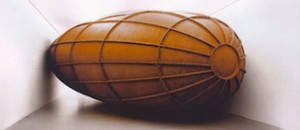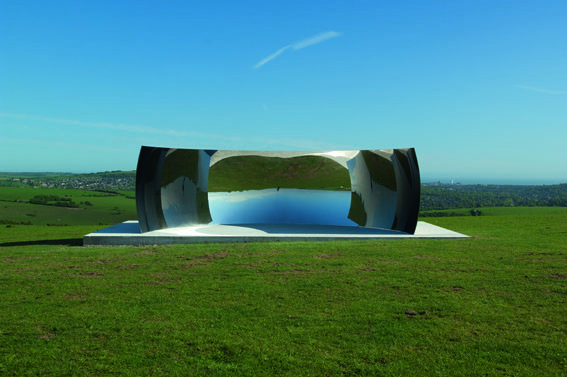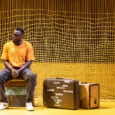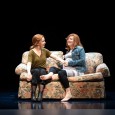I was going to call this review Anish Kapoor: The Joy of Size. Then, for obvious reasons, I dropped that in favour of Anish Kapoor: The Joy of Surface, then settled on Anish Kapoor: The Joy of Looking.
And then settled on none of the above as I realised there are too many joys to the work of the superstar Mumbai-born, London-based sculptor, the above being only three of them.
Kapoor rose to international pop-consciousness during the 2012 London Olympics with his design of the ArcelorMittal Orbit, the controversial public sculpture made in collaboration with architect Cecil Balmond to celebrate the event.
The works assembled for the current Anish Kapoor exhibition at Sydney’s Museum of Contemporary Art could not be more different from the Orbit. And yet, in common with the London piece, they are audacious, utterly transfixing and, yes, a joy to look at.
Looking at a work of art – looking without thinking, without looking through a latticework of artspeak and high theory – is a rare pleasure in 21st century art. Of course, Kapoor’s work has as much depth as you like – the artist himself speaks of “layers of meaning” (while rarely suggesting what these meanings might be).

My Red Homeland Anish Kapoor
wax and oil-based paint, steel arm, motor
Image courtesy and © the artist Photo: Nic Tenwiggenhorn
A good example is the first piece we see inside the MCA. My Red Homeland fills an entire room with a circular mound of red wax that has been gouged by a slowly rotating block of steel. The block moves as slowly and as uncaring as a glacier through the fleshy wax. The red could be an allusion to Kapoor’s saffron-Hindu homeland but the inescapable impression is one of meat and the relentless grind of violent history through human flesh. After all, our bodies are our closest homeland.
Up on Level 3 we first see Untitled 2012 (many of Kapoor’s works are untitled – in other artists often a quasi-misterioso conceit but in his case perfectly suited to their featureless, surface-as-substance conception).
Untitled 2012 is one of Kapoor’s ‘void’ works, a series that goes back to the 1980s. It shows perfectly how he plays with our perspectives and perceptions – how he shows us that looking is not as simple an act as we may believe.
From the distance Untitled 2012 is a richly pigmented circle; closer we see it is a cup shape, coming out concave from the wall. But as we continue to look, our minds flip it to convex, bulging out at us. Which is it? It is all three – a trinity of co-existing mental constructs.
This play with our eyes and minds continues through Kapoor’s use of extremes – ultra mirror smoothness or impossibly dense velvety texture, super-saturated colour or polished steel colourlessness.
A piece such as My Body, Your Body is so dark and saturated, it is only after your eyes adjust that you see it is not flat at all but a circular void that pulls back into the wall – like a black hole in physics that is so dense it sucks the very light from the sky.
His S-Curve’ and ‘C-Curve – two huge highly polished stainless steel pieces that take up an entire room – is equally existent/non-existent. Kapoor talks of his Sky Mirror, which sits on the MCA lawn outside, as ‘both a space and an object’. This applies to these two staggering fun-park mirrors as well.
Because their surfaces are only mirrors they have no skin except what is reflected – the gallery walls, the people, all distorted and topsy-turvy due to the curved planes. They are there, but somehow not there. Once again, it is our mind putting it all together (somewhat unbelievingly).
This might be High Art but I am sure the people goofing off and pulling silly faces into the distorting mirrors of S-Curve’ and ‘C-Curve would make Kapoor grin. It is also that silliness in the gallery that makes the piece in the next room, 2008’s Memory, even more somber than it is (if that were possible).
Memory is a work so big it fills an entire gallery to the extent that there is no room to walk around it. The idea is that since our view of the whole object is restricted, we need to knit together our separate (remembered) views of it in our minds. That is the concept but the effect – like My Red Homeland – is entirely visceral.

Anish Kapoor Memory 2008
Image courtesy the artist and Deutsche Guggenheim © the artist Photo: Mathias Schormann
Memory is a huge, bulbous, bomb-shaped structure made of segments of rusted Cor-Ten steel, bolted together. To anyone who lived through the Cold War, beneath the shadow of The Bomb, through any part of the twentieth century – the century of two World Wars, Vietnam, Korea and endless mechanised slaughter – the memories stirred up by the rusted, pregnant bloat of Memory are deep and sad.
So much large-scale sculpture is only about surface and shape and space with little room for joy in its edges and curves. This exhibition has joy in abundance – but also contemplation, spirituality (When I Am Pregnant was inspired by the artist’s 1991 trip to Uluru) and new questions.
While you were just looking, Anish Kapoor made you do so much more.
Anish Kapoor runs until April 1, 2013 at The Museum of Contemporary Art, Circular Quay, Sydney.






this is a great representation of Kapoor’s work – through the years and blend of smaller scale with the huge works. His passion for creating huge scale art shows through